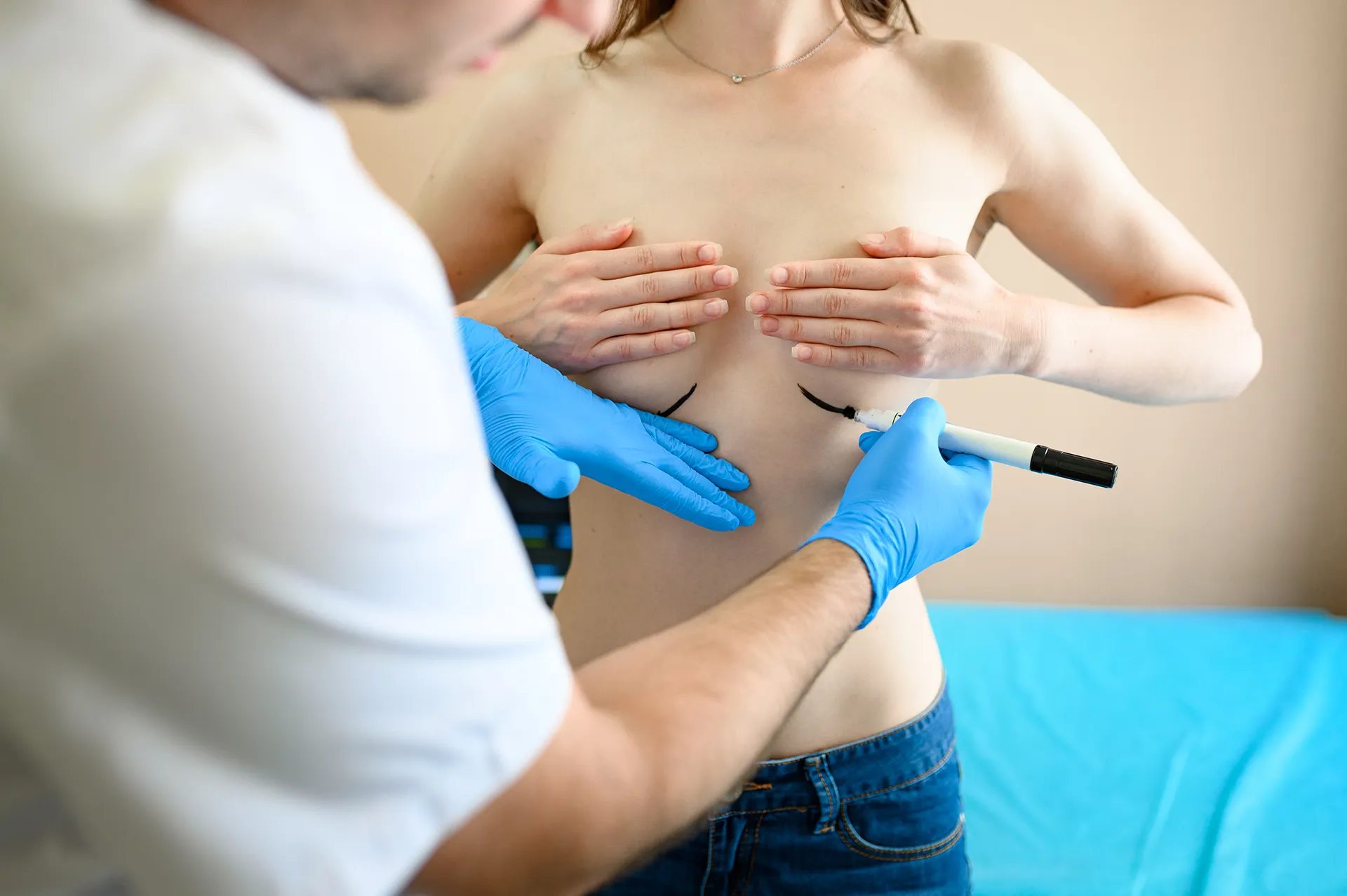There are 2 main types of reconstruction, reconstruction using implants or reconstruction using your own tissues which in termed “Autologous” reconstruction.
Implant based reconstructions use artificial implants to recreate the breast mound whereas autologous reconstructions use tissue from elsewhere in the body to recreate the breast. Which option is most suitable for you depends on the characteristics of your remaining natural breast, the quality of reconstruction required and the type of surgery you are prepared to undergo to achieve your reconstruction.
Implant based
Pure implant only reconstructions involve making a space between your ribcage and pectoral muscles and inserting an implant into this space (sub-pectoral implant reconstruction). The overlying skin is then sutured together to close the wound. The implants are usually expandable implants, which are slowly enlarged over 3 to 6 months to give the desired shape and size and then may be changed to a permanent silicone implant. Implant types are covered in more detail in the Expander / Implant section.
Implant assisted reconstructions involve the use of a muscle flap in combination with an implant. The commonest type of implant assisted reconstruction we use used to be the Latissimus-dorsi (LD) flap. The LD muscle is a thin sheet of muscle on the back which is mobilized together with fat and skin and move to the front to create a pocket for an implant to be placed in (see examples of this reconstruction in the photo section of this website). However over the last 10 years Acelluar Dermal Matrix or ADM as it is known have become routinely used to allow us to perform one stage reconstruction with a more natural finish using the ADM (a denatured sheet of collagen) to provide an internal pocket or “internal bra” to support placement of a permanent implant in a single operation and avoiding 2 stage reconstruction with the process of tissue expansion.
Autologous
Autologous reconstructions involve moving tissue from your back, buttocks or abdomen to the site of your breast and reshaping the tissue to form the new breast mound. As the tissue is alive and natural, it provides the most natural shape and feel to the reconstructed breast at the expense of undergoing surgery and creating scars in healthy parts of your body. In contrast to prosthetic reconstructions, there is a full-size breast mound immediately after the operation, although it is likely to change shape and size slightly over the first few months following reconstruction. The commonest autologous reconstruction we perform is the DIEP flap in conjunction with our Plastic Surgical colleagues. This involves the transfer of abdominal tissue to recreate the breast.
Nipple reconstruction is performed as a final stage of breast reconstruction, after the breast has reached its final shape and size, and when you are happy with your reconstruction. As there are inevitably changes that occur in the breast following reconstruction, creating a nipple too early would result in a poor match between the two sides.
What is a Flap Reconstruction?
A ‘flap’ is a volume of living tissue transferred from one site in the body to the breast, along with the blood vessels keeping it alive. The 2 main techniques for transferring tissue in this way are either to keep the blood vessels attached, but to rotate the tissue around the blood vessels to its new position (pedicled flap e.g LD flap), or to completely detach the tissue and blood vessels from the body, move the whole block of tissue to its new site, then re-connect the blood vessels to other vessels near the breast using microsurgical techniques (free flap e.g DIEP flap).

How do the different types of reconstruction compare?
Implant Based Reconstruction
Advantages
- Shorter operating time
- Short anaesthetic and recovery time
- No operating on healthy tissue or extra scars
- No missing tissue missing elsewhere in the body
Disadvantages
- Slower reconstructive process with expansion of implants
- Less natural breast texture
- Can feel cold
Autologous Reconstruction
Advantages
- Most natural feel
- Most durable
- Can give best cosmetic result
- No implant required
- Warm
Disadvantages
- Major operation
- Extra scars
- Possible complications from surgery at other body sites
- Longer hospital stay

Timing of breast reconstruction
One of the first choices you will have is whether to undergo immediate or delayed reconstruction. Immediate reconstruction is performed during the same operation as the mastectomy. Delayed reconstruction involves only performing the mastectomy at the first operation. After you have fully recovered and any additional necessary treatment has been completed, a second operation is performed to reconstruct the breast. These are generally a few months apart.
Traditionally patients who have larger tumours or positive nodes were recommended to have their reconstruction delayed until after radiotherapy and chemotherapy. However with better surgical techniques and more people being offered treatments such as chemotherapy first even before surgery and radiotherapy, this is not always the case.
There are certain groups of patients where a “temporary” reconstruction can be performed, usually with a tissue expander implant to preserve the skin to allow a skin sparing mastectomy and immediate “temporary” reconstruction to take place. The other treatments such as radiotherapy can then be given and the definitive reconstruction such as a flap based reconstruction can be performed after the other treatments have been given. This allows the final reconstruction to not receive radiotherapy directly, improving the long term results.
Here are some advantages and disadvantages of each type of procedure:
Immediate Reconstruction
Advantages
- Better cosmetic results
- Smaller breast scars
- One anaesthetic and recovery period
- One hospital stay
- Lower psychological impact - no time without a breast shape
Disadvantages
- Longer anaesthetic and recovery time
- Longer wait for surgery
- Increased risk of infection
- Distortion of reconstructed breast if radiotherapy is required
Delayed Reconstruction
Advantages
- Staggered surgery resulting in easier and shorter recovery after each procedure
- Time to consider whether reconstruction is right for you without delaying cancer treatment
- Less to deal with at once
Disadvantages
- Longer breast scars
- Harder to obtain excellent cosmesis
- More time off work due to multiple operations Any type of mastectomy and reconstruction will result in scarring of the breast.

Awarded the Certificate of Excellence 2019 from I Want Great Care

Awarded the Certificate of Excellence 2018 from I Want Great Care





